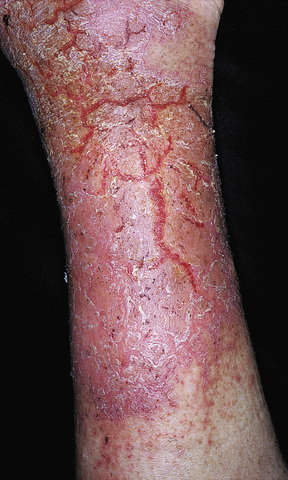Cené L. Gibson Dry skin (xerosis) is literally skin that lacks moisture or water. It is often characterized as rough or xerotic. Dry skin is common in dry climates and during the winter months. It is especially prevalent in older adults. Older skin (older than 60 years) is affected by physiologic changes, the wear and tear of aging, hormone deficits, and the cumulative effect of years of sun exposure. By the age of 70 years, nearly all adults are affected with dry skin, resulting in significant morbidity and reduction in quality of life.1 Teenage skin is susceptible to drying because of the hormonal changes of puberty. Teens are also susceptible because of application of chemical preparations, such as makeup and cleansers. Obesity, now an epidemic in the Western world, is also responsible for changes in skin barrier function. Studies suggest that obese individuals have increased transdermal water loss and erythema compared with control subjects, resulting in an altered epidermal barrier.2 Environments in which the humidity is below 30% cause dehydration of the stratum corneum layer of the skin. Cold air and heat in buildings, cars, and homes contribute to skin dehydration, especially during the winter. The moisture content of the skin contributes to its overall elasticity, tone, smoothness, and softness. Dysfunction of the epidermis can allow water to be lost, resulting in drying. The stratum corneum of the epidermis is the primary protective layer of the skin. The thickness of the stratum corneum varies with location on the body. It averages 0.1 mm in thickness and is made up of flattened keratinocytes. These cells originate below the epidermal layer and migrate to the surface, where they die and slough in the continual process of desquamation. The process of migration (from below the corneum) to the surface takes 28 days. The stratum corneum layer is composed of lipids, water, proteins, and salts. Lipids come from sebaceous gland secretions in the form of sebum; the salts come from the sweat or apocrine glands. This lipid layer forms a natural emulsion of lipid and water. Depending on genetics and subject to age, climate, and time of year, this layer can be either more oil-in-water emulsion or water-in-oil emulsion.1,2 Hormones also play a role in this layer. Androgenic hormones tend to stimulate the layer, whereas estrogen, progesterone, and the corticosteroids tend to inhibit production of this layer.3 Hormone production is relatively low during childhood, peaks during adolescence, decreases after the age of 35 years, and dramatically decreases after the age of 60 years. In older adults, the decrease in sweat and sebum production from glandular tissue leads to water loss through the skin, resulting in a decreased ability to repair skin defects.1 If the skin is working properly, the lipid layer and lower water barrier maintain the skin in a supple state. The lipid layer prevents water absorption by acting as a repellent. The lower water barrier prevents drying out and potential damage to lower skin structures in the dermis and subcutaneous layers. Repeated exposure to solvents and soaps removes lipids from the skin. Loss of water, lipids, or proteins alters overall skin integrity. Some patients report having dry skin most of their lives; in others, the problem developed with aging. Typically, patients with dry skin will experience skin changes with the seasons or after an illness. Initially, dry skin appears as a rough patch that itches. Pruritus is worse on the lower extremities, which have less fat and muscle mass and therefore less ability to replace the lipid layer elements. The hands and face are also common sites for dry skin because of exposure to wind or air and handwashing. Dry skin has a rough appearance and is not supple. The presence of cracks and fissures indicates a severe condition. Eczema craquelé is a condition that develops on lower legs or arms when skin is dry; the skin will have an uneven diamond pattern with erythema at the edges (Figure 52-1).
Dry Skin
Definition and Epidemiology
Pathophysiology
Clinical Presentation and Physical Examination
Dry Skin
Chapter 52







